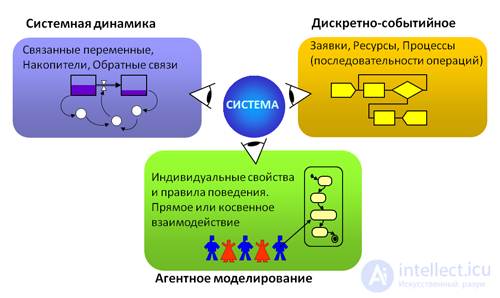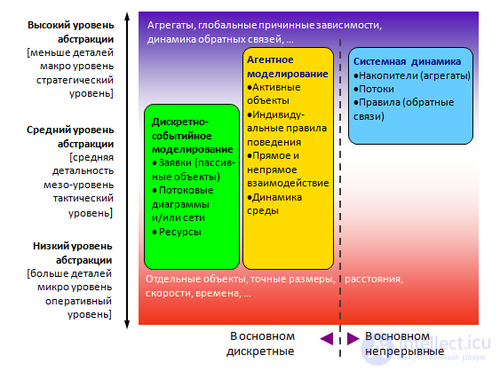Simulation (situational modeling) - a method that allows you to build models that describe the processes as they would have passed in reality. Such a model can be “lost” in time for both one test and a given set of them. The results will be determined by the random nature of the processes. From these data, you can get a fairly stable statistics.
Simulation modeling is a research method in which the system under study is replaced by a model that describes the real system with sufficient accuracy, with which experiments are carried out in order to obtain information about this system. Experimenting with a model is called imitation (imitation is the comprehension of the essence of a phenomenon, without resorting to experiments on a real object).
Simulation is a special case of mathematical modeling. There is a class of objects for which, for various reasons, analytical models are not developed, or methods for solving the resulting model are not developed. In this case, the analytical model is replaced by a simulator or a simulation model.
Simulation modeling is sometimes referred to as obtaining partial numerical solutions of a formulated problem based on analytical solutions or using numerical methods [1] .
A simulation model is a logical-mathematical description of an object that can be used for computer-based experimentation in order to design, analyze, and evaluate the functioning of an object.
Application of simulation
Imitation modeling is resorted to when:
- expensive or impossible to experiment on a real object;
- It is impossible to build an analytical model: the system has time, causal relationships, consequence, nonlinearity, stochastic (random) variables;
- It is necessary to simulate the behavior of the system in time.
The goal of simulation modeling is to reproduce the behavior of the system under study based on the results of the analysis of the most significant interrelationships between its elements or in other words - the development of a simulation (English simulation modeling ) of the subject area for various experiments.
Types of simulation

Three simulation approaches

Approaches of simulation on the scale of abstraction
- Agent-based modeling is a relatively new (1990s-2000s) direction in simulation modeling, which is used to study decentralized systems, the dynamics of which are not determined by global rules and laws (as in other modeling paradigms), but vice versa, when these global rules and laws are the result of individual activity of group members. The purpose of agent models is to get an idea of these global rules, the general behavior of the system, based on assumptions about the individual, particular behavior of its individual active objects and the interaction of these objects in the system. An agent is an entity that has activity, autonomous behavior, can make decisions in accordance with a certain set of rules, interact with the environment, and also change itself.
- Discrete-event modeling is a modeling approach that offers to abstract from the continuous nature of events and consider only the main events of the simulated system, such as: “waiting”, “order processing”, “movement with cargo”, “unloading” and others. Discrete event modeling is most developed and has a huge scope of applications - from logistics and queuing systems to transport and production systems. This type of modeling is most suitable for modeling production processes. Founded by Jeffrey Gordon in the 1960s.
- System dynamics is a modeling paradigm where graphs of causal relationships and global effects of some parameters on others over time are built for the system under study, and then the model created on the basis of these diagrams is simulated on a computer. In fact, this type of modeling, more than any other paradigm, helps to understand the essence of the ongoing identification of cause-effect relationships between objects and phenomena. Using system dynamics, models of business processes, city development, production models, population dynamics, ecology and epidemic development are built. The method was founded by Jay Forrester in the 1950s.
Areas of use
- Business processes
- Business simulation
- Fighting
- Population dynamics
- Road traffic
- IT infrastructure
- Mathematical modeling of historical processes
- Logistics
- Pedestrian dynamics
- Production
- Market and competition
- Service centres
- Supply chain
- Traffic
- Project management
- Health economics
- Ecosystem
- Information Security
- Relay Protection
Free simulation systems
- Plant Simulation (student version)
- GPSS
Free simulation systems
see also
- Petri nets
- Network modeling
- Simulation of complex systems
- Simulation in PTV
Comments
To leave a comment
System modeling
Terms: System modeling